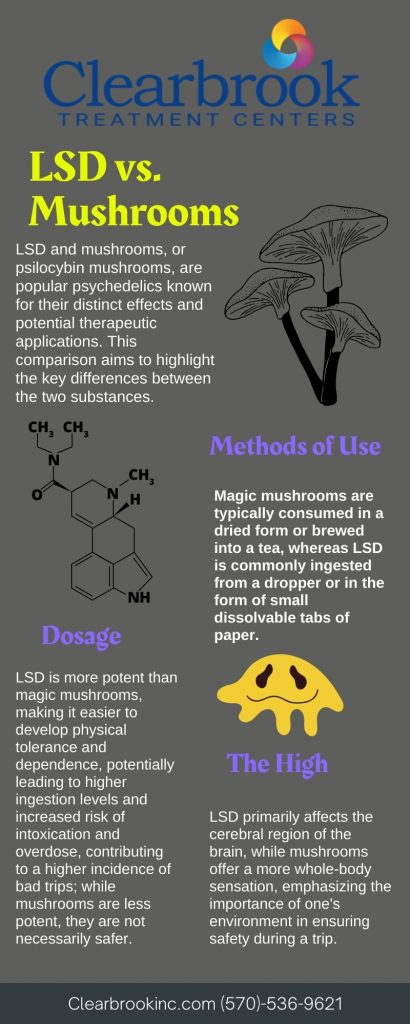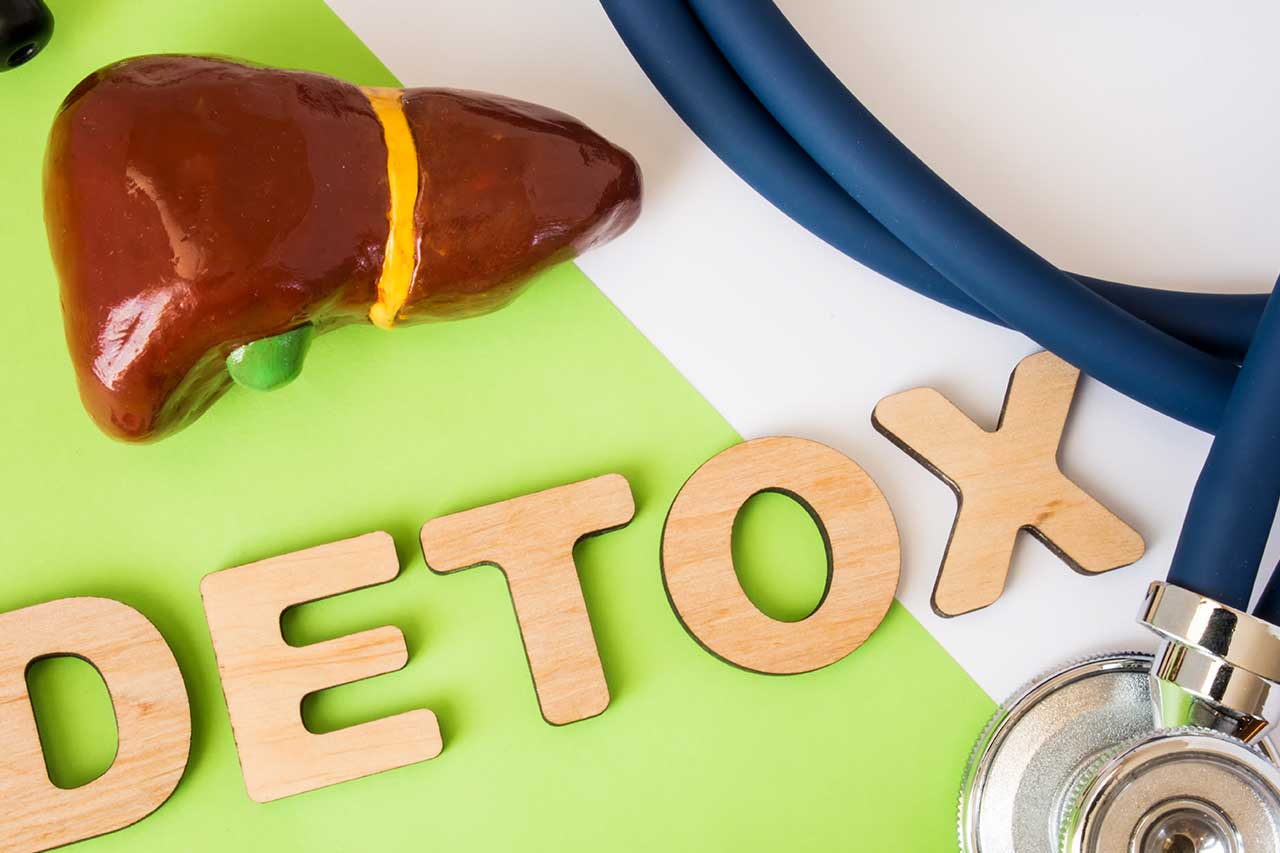LSD vs. Mushrooms: What Are They?
LSD
Also known as acid, LSD (lysergic acid diethylamide) is a synthetic chemical that’s used recreationally. LSD is man-made from a substance that’s found in ergot, which is a fungus that grows on rye. LSD belongs to a class of drugs called psychedelics.
When taken in small doses, acid can produce mild changes in perception, thought, and mood. Larger doses of LSD may produce more intense side effects and disturbances, such as visual hallucinations and distortions in the perception of space and time.
In its pure state, LSD comes as a white, odorless crystalline substance, meaning it takes a rock-like appearance. The drug is so potent that an effective dose is small enough to be nearly invisible. As a result, acid is usually diluted or mixed with other substances or materials to make the drug heavier.
This is another way for drug dealers to make more profit from less product. LSD is commonly sold in the form of drops dried onto gelatin sheets, pieces of blotting paper, and sugar cubes, all of which are ingested orally. Liquid formulations of acid, as well as tablets and capsules, are also common.
“Magic” Mushrooms
Also called shrooms, magic mushrooms are wild mushrooms that contain psilocybin, a naturally-occurring psychoactive and hallucinogenic compound. Psilocybin is classified as a Schedule I drug according to the Drug Enforcement Agency (DEA), meaning it has a high potential for abuse and no accepted medical use in the United States.
While certain cultures used some mushrooms for their hallucinogenic properties for centuries, it wasn’t until 1938 that psilocybin was isolated by Dr. Albert Hofmann, who also discovered LSD. Shrooms are usually dried and eaten either alone or mixed with foods or drinks.
As hallucinogens, magic mushrooms can cause users to hear, feel, and see things that seem real but aren’t, otherwise known as hallucinations. While shrooms are sought after for a peaceful high, these substances are known to produce adverse reactions like anxiety, frightening hallucinations, paranoia, and confusion in some users. These episodes are known as “bad trips,” and they’re usually unpredictable.
Considering that it’s basically impossible to determine the concentration of psilocybin in mushrooms, it’s impossible to determine how a person will react to the drug. Depending on the dose and the person’s familiarity with the drug, side effects can vary from pleasant to terrifying and uncomfortable.
What’s the Difference Between LSD and Mushrooms?
The main difference between LSD and mushrooms is that LSD is a synthetic drug made from ergot, while mushrooms are naturally occurring fungi that contain the psychoactive compound psilocybin. While both drugs can produce “trips” and other similar side effects, comparisons of mushrooms vs. LSD have concluded varying differences.
 Side Effects
Side Effects
Various types of mushrooms produce psychoactive effects. However, most shrooms with psychoactive properties are of the Psilocybe cubensis species, meaning they contain psilocybin. On the other hand, LSD has less natural properties and was originally synthesized in a lab. Despite their different origins, LSD and mushroom trips produce similar side effects:
- Distorted perception of time and space
- Visual and auditory hallucinations (seeing and hearing things that aren’t real)
- The sensation that solid objects are melting or stationary objects are moving
- Altered sense of taste, touch, and smell
- Increased empathy and openness to new ideas
- Increased sense of connection to others
- Spiritual awakenings
- Excitement
- Paranoid delusions
- Anxiety
- Fear of death
- Rapid heart rate
- Elevated blood pressure
- Dilated pupils
- Sweating, numbness, and tremors
Despite similar side effects, LSD and mushroom trips may vary depending on factors like onset time, duration of effects, dosage, and frequency of use. It’s nearly impossible to tell how someone will react to either of these drugs or whether users will experience a “good” or “bad” trip.
The duration of shroom and acid effects also differ. While a mushroom trip usually lasts about 6 hours, an LSD trip can continue for 10 hours. Despite this, acid trips are perceived to proceed more rapidly than shroom trips.
Methods of Use
Another difference between LSD vs. magic mushrooms is that mushrooms are usually dried and eaten or brewed into a tea to be ingested, while LSD is normally taken from a dropper or applied as small tabs of paper that dissolve in the mouth.
Dosage
While physical tolerance and dependence are possible to develop with both LSD and mushroom use, LSD is more potent than magic mushrooms, meaning it takes less acid to get high and become dependent. As a result, users are more likely to ingest more LSD than their bodies can handle, increasing the risk of intoxication and overdose.
Combined with a longer duration of side effects, acid’s high potency might explain why there are more reports of bad trips when using acid than shrooms. However, that’s not to say that shrooms are necessarily safer. They’re merely not as potent.
The Trip (High)
Furthermore, while their side effects are similar, shrooms and acid produce different types of highs or trips. While an LSD trip occurs mostly in the cerebral region of the brain, mushrooms tend to produce a whole-body experience. As a result, a user’s setting can greatly determine how safe they are during a trip.
Unfortunately, many people use LSD and other similar drugs in social settings like clubs, raves, and musical festivals. They often neglect to stay hydrated and other basic needs, which increases the risk of dehydration, loss of consciousness, and other adverse reactions. The same goes for someone taking mushrooms.
The Dangers
Both mushrooms and LSD present various risks, including:
- Rapid heart rate
- Increased blood pressure
- Sweating
- Numbness
- Tremors
- Dehydration
- Impaired judgment
The side effects are especially concerning for people who have cardiac or vascular problems. Psychologically, there’s always the added risk of an unpleasant trip marked by paranoia, anxiety, and fear. While these symptoms usually wear off in a day, some people may experience flashbacks of past trips, a condition known as hallucinogen-persisting perception disorder (HPPD).
Although this condition is rare, chronic shrooms and acid users are more likely to experience HPPD if they have any underlying mental illnesses. People with HPPD experience recurring symptoms or flashbacks weeks, months, or even years after an LSD or mushroom trip.
For users who also take antidepressants like St. John’s wort, SSRIs, MAOIs, ingesting LSD or mushrooms can cause high levels of the chemical serotonin in the body. This could potentially cause a condition called serotonin syndrome, in which the individual might experience symptoms like confusion, disorientation, irritability, anxiety, muscle spasms and rigidity, and more.
What About Mixing Mushrooms and LSD?
Taking LSD with mushrooms can intensify the side effects of both drugs, which isn’t a good thing. This combination may increase your likelihood of experiencing a bad trip, especially in people who have experienced one before. Combining shrooms and acid can also increase your risk of serotonin syndrome, which isn’t pleasant. While some people try microdosing or starting with small doses of a drug at first to slowly tolerate the combined effects of these drugs, the cons outweigh the benefits.
Help for Drug Abuse at Clearbrook
While shrooms and LSD have a low potential for physical dependency, psychological dependency is possible. This refers to an emotional or mental tie to a drug, in which the person believes they must use either drug to feel “normal” or good. However, what happens most times is that a person becomes bored of a drug’s effects and desires to try new outlets.
As a result, what starts as a curiosity about shrooms can turn into a more serious depressant or stimulant addiction. If you or someone you care about is addicted to drugs or alcohol, don’t wait until it’s too late to get them help. Our Northeast recovery center offers inpatient drug treatment in Pennsylvania that incorporates both detox and therapy modalities to treat the person as a whole.
While our medical team administers medically monitored detox to safely and effectively mitigate withdrawal symptoms, our therapists and licensed clinicians help clients work through the emotional and mental hold of drugs or alcohol. Together, these treatments help clients take the necessary steps towards a sober future.







